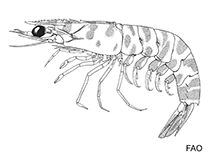Protrachypene precipua Burkenroad, 1934
Titi shrimpWarning: DOMDocument::load(): SSL operation failed with code 1. OpenSSL Error messages: error:140770FC:SSL routines:SSL23_GET_SERVER_HELLO:unknown protocol in C:\Apache24\htdocs\includes\SpeciesSummary.lib.php on line 1236
Warning: DOMDocument::load(): Failed to enable crypto in C:\Apache24\htdocs\includes\SpeciesSummary.lib.php on line 1236
Warning: DOMDocument::load(https://sealifebase.nrm.se/webservice/AquaMaps/getAMap.php?genus=Protrachypene&species=precipua): failed to open stream: operation failed in C:\Apache24\htdocs\includes\SpeciesSummary.lib.php on line 1236
Warning: DOMDocument::load(): I/O warning : failed to load external entity "https://sealifebase.nrm.se/webservice/AquaMaps/getAMap.php?genus=Protrachypene&species=precipua" in C:\Apache24\htdocs\includes\SpeciesSummary.lib.php on line 1236
Adicionar o seu Fotografias
Imagem do Google | No image available for this species;
drawing shows typical species in Penaeidae.
Imagem do Google | No image available for this species;
drawing shows typical species in Penaeidae.
Classification / Names Common names | Synonyms | CoL | ITIS | WoRMS
| Decapoda | Penaeidae
Environment: milieu / climate zone / depth range / distribution range Ecologia
; intervalo de profundidade 15 - 40 m (Ref. 83922). Tropical; 15°N - 4°S, 92°W - 77°W
Distribuição Países | Áreas FAO | Ecossistemas | Ocorrências | Introduções
Eastern Pacific: From Guatemala to Tumbes, Peru.
Length at first maturity / Tamanho / Peso / Idade
Maturity: Lm ? range ? - ? cm Max length : 7.5 cm TL macho/indeterminado; (Ref. 8); 8.8 cm TL (female)
Maximum carapace length: 1.38 cm (male); 1.53 cm (female) (Ref. 8). Minimum depth from Ref. 8. This benthic species is found in muddy bottoms (Ref. 83922). In general, the majority of penaeids are omnivorous or detritus feeders (Ref. 105082).
Life cycle and mating behavior Maturidade | Reprodução | Desova | Ovos | Fecundidade | Larvas
Members of the order Decapoda are mostly gonochoric. Mating behavior: Precopulatory courtship ritual is common (through olfactory and tactile cues); usually indirect sperm transfer.
Referência principal
Referências | Coordenador | Colaboradores
Holthuis, L.B. 1980. (Ref. 8)
Categoria na Lista Vermelha da IUCN (Ref. 130435)
Categoria CITES (Ref. 108899)
Not Evaluated
CMS (Ref. 116361)
Not Evaluated
Ameaça para o homem
Utilização humana
Pescarias: pouco comercial
FAO - pescarias: landings | FishSource | Sea Around Us
Ferramentas
Mais informação
Idade/Tamanho
Crescimento
Comprimento-peso
Comprimento-comprimento
Morfologia
Larvas
Abundância
Crescimento
Comprimento-peso
Comprimento-comprimento
Morfologia
Larvas
Abundância
Fontes da internet
BHL | BOLD Systems | CISTI | DiscoverLife | FAO(pescarias: ; publication : search) | Fishipedia | GenBank (genoma, nucleotídeo) | GloBI | Gomexsi | Google Books | Google Scholar | Google | PubMed | Árvore da vida | Wikipedia (ir para, procurar) | Registo zoológico
Estimates based on models
Preferred temperature
(Ref. 115969): 20.6 - 28.8, mean 25.8 (based on 40 cells).
Nutrients: Calcium = 109 [35, 184] mg/100g; Iron = 1.59 [1.21, 1.97] mg/100g; Protein = 20.2 [19.2, 21.3] %; Omega3 = 0.285 [0.185, 0.386] g/100g; Selenium = 48.3 [-31.7, 128.3] μg/100g; VitaminA = 0 μg/100g; Zinc = 1.79 [1.17, 2.40] mg/100g (wet weight).



